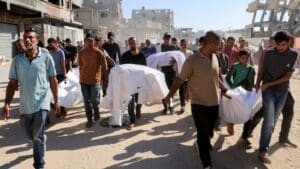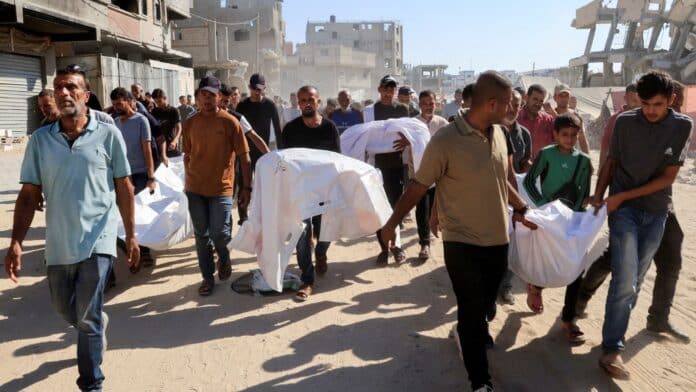Gaza Ceasefire Talks Collapse: Israeli Airstrikes Intensify Across Gaza Strip
Finix News Desk | Dhaka | Updated: July 13, 2025
The Gaza ceasefire talks have collapsed, leading to a resurgence of Israeli airstrikes across the war-torn region. What was expected to be a turning point toward a peaceful resolution has now deteriorated into one of the bloodiest phases of the conflict since October 2023.

The conflict between Israel and Hamas continues to escalate as ceasefire negotiations break down, leading to renewed and intensified bombardment across the Gaza Strip. What was hoped to be a turning point toward peace has now reverted into one of the most violent phases in recent months. As the death toll mounts and international pressure grows, both sides appear entrenched in their demands, while civilians face the brunt of the ongoing war.
🇵🇸 Stalled Ceasefire Talks
The latest round of Gaza ceasefire talks, which were being held indirectly through mediators in Qatar and Egypt, failed to produce any agreement. Hamas leaders have reportedly rejected the proposed draft that included a phased ceasefire, release of hostages, and conditional reconstruction plans. According to sources close to the negotiation, Hamas has reiterated its position that a complete Israeli withdrawal from Gaza must precede any further progress.
On the other hand, Israeli officials remain firm in their stance that Hamas must first release hostages and disarm militarily before any long-term ceasefire is established. The Israeli government has also maintained that its military will continue to operate in parts of Gaza to prevent Hamas from regaining control.
These diverging positions have created a deadlock that has pushed the situation back into open conflict.
💣 Intensified Israeli Bombardment
Following the failure of diplomatic efforts, Israeli forces have launched a new wave of airstrikes and ground offensives targeting areas across the Gaza Strip. The Israel Defense Forces (IDF) claim they are targeting Hamas infrastructure, including weapons caches, tunnels, and command centers.
However, the reality on the ground paints a different picture. According to local health authorities in Gaza, at least 400 Palestinians have been killed in the past week alone, with a significant number being women and children. Residential areas, markets, and even UN-run shelters have been caught in the crossfire.
One of the deadliest strikes occurred in the northern district of Gaza City, where a residential building sheltering dozens of displaced families was bombed, resulting in over 60 casualties.
Eyewitnesses describe the situation as “apocalyptic,” with constant explosions, collapsing buildings, and no safe place to hide. The lack of electricity, water, and medical aid is compounding the humanitarian crisis.
🧕 Civilian Toll and Humanitarian Collapse
The civilian population in Gaza is experiencing one of the worst humanitarian crises in recent memory. Hospitals are running out of fuel and supplies, while makeshift shelters are overwhelmed. More than 1.5 million people have been displaced, many of them multiple times due to shifting frontlines and airstrike warnings.
Medical professionals in Gaza report a severe shortage of medicine, surgical tools, and anesthesia. Many injured civilians are unable to receive proper treatment, and emergency surgeries are being performed without basic medical equipment.
Food insecurity is also worsening. Long lines at humanitarian aid centers often end in tragedy, as Israeli forces have been accused of opening fire near food distribution zones, citing security threats. Dozens of people have been killed while trying to access basic necessities like bread and water.
🧭 Key Sticking Points in Negotiations
The failure of the Gaza ceasefire talks revolves around several critical disagreements:
- Hostage Release: Israel wants hostages held by Hamas to be freed as a precondition, while Hamas demands a mutual release of Palestinian prisoners held in Israeli jails.
- Territorial Control: Hamas insists on full Israeli withdrawal from all of Gaza, whereas Israel seeks to maintain a buffer zone and limited troop presence for security reasons.
- Reconstruction Responsibility: There is no clear agreement on who would oversee reconstruction. Hamas opposes international bodies that might limit their influence.
- Security Guarantees: Israel wants a long-term commitment from Hamas to demilitarize, which Hamas refuses without political concessions.
- Humanitarian Access: While both sides claim to support aid access, implementation has been sporadic and often interrupted by ongoing violence.
🌍 International Response and Pressure
The international community is growing increasingly vocal in its condemnation of the ongoing violence. The United Nations, European Union, and Arab League have all called for an immediate humanitarian ceasefire to allow for aid delivery and medical evacuation.
In Washington, diplomatic efforts are underway, though the United States continues to back Israel’s right to self-defense. Meanwhile, several human rights organizations have urged the International Criminal Court (ICC) to investigate potential war crimes committed by both sides.
In the United Kingdom, dozens of lawmakers have demanded that the British government recognize a Palestinian state as a step toward a two-state solution.
The global public opinion is also shifting. Protests have erupted in major cities around the world, calling for an end to the conflict and urging governments to act more decisively.
🇮🇱 Internal Pressure in Israel
Inside Israel, the conflict is also sparking domestic tension. Families of Israeli hostages held in Gaza are demanding the government do more to secure their release. Large-scale protests in Tel Aviv and Jerusalem have increased in frequency, with demonstrators accusing the Netanyahu administration of prolonging the war for political gain.
Some Israeli soldiers and reservists have even filed legal petitions against certain military operations, arguing that they violate ethical and legal standards of war.
These internal divisions are adding another layer of complexity to an already fragile political environment in Israel.
📉 Economic and Strategic Impact
The ongoing war has already caused substantial economic damage on both sides. Gaza’s economy is virtually non-existent at this point, with industries, agriculture, and markets completely shut down.
In Israel, the cost of war is mounting. Tourism has plummeted, the tech industry is facing global divestment campaigns, and military expenditures are draining public resources. The longer the conflict continues, the greater the risk of regional destabilization.
Tensions have also increased with Hezbollah in Lebanon and other militias in Syria and Iraq, raising fears that the conflict could spread beyond Gaza.
The situation in Gaza has reached a dangerous turning point. With ceasefire talks stalled and military operations intensifying, the prospects for peace seem more distant than ever. While both sides remain firm in their demands, innocent civilians continue to pay the highest price.
The need for international mediation, accountability, and humanitarian intervention is now more urgent than at any point in this conflict. Until a genuine and enforceable agreement is reached, the people of Gaza—and indeed the region—will remain caught in a cycle of violence, despair, and destruction.
Finix News | Reporting Truth Beyond Borders:
For media inquiries or permissions, contact: [email protected]
Follow us on Twitter/X | Facebook | LinkedIn
More News for You..
- Iran Denies Reports of Fighter Jet Purchase Talks with China, Labels Media Claims as Fabricated.
- Zohran Mamdani Leads NYC Mayoral Race Amid False ‘Communist’ Accusations..
- Double Disaster in Iran: Earthquake or Secret Nuclear Test?
- Iran – Israel Military Tensions: Where Do They Stand in the Balance of Power?



